
Sóller and Fornalutx
"Sóller is, without doubt, the prettiest town on the island and, I would even dare say, in the world, bringing together everything we might desire: the prodigious beauty of the surrounding landscape, the productivity of the land watered by hundreds of streams which descend from the heights and favoring the exuberant southern vegetation, the clean air perfumed by the orange trees, the clear and luminous blue sky, and the warm and healthy climate.
The town has 4,932 inhabitants and 1,069 houses, of which only 45 are uninhabited. It’s found in the center of a wide plain which opens to the north towards the sea.
Sóller’s construction is very dense. The majority of streets are narrow, winding and paved with stones. It has three important streets, also providing access to the town: Carrer de Palma which leads to the road to the capital, Carrer de la Lluna which goes to Fornalutx, and Carrer de la Mar which heads to the port. They all converge at the main plaza. The majority of Sóller’s homes are not whitewashed, and many have replaced gutters with a simple slope of the roof (“aiguavés”). Three-story houses abound, with 746 in number; there are 223 with two stories, and 41 with just one. There are 59 with four stories. Many have a half-point arch entrance, though more modern houses have a segmental or diminished arch. Some have eaves, others a corbel of two or three rows of tiles above the entrance. On the underside of these on some of the oldest houses, the tiles have often been enameled in diverse ways. External walls often feature niches with images of saints, and, on the main street, we find the different stations of the cross on ceramic tiles.
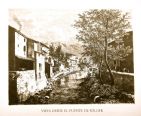 Two bridges cross the stream: Pont de Sa Plaça with diminished arches and made of stone from Santanyí and stone blocks, and, a bit higher up, Pont de Can Fiol. Next to the first bridge is the unfailing Plaça de la Constitució, never absent in any town. Here it also serves as the fruit and vegetable market and in summer hosts the public dances held during local festivities. It also hosts the annual market on the second Sunday in the month of May. It’s a wide plaza, and in its center is a square space surrounded by trees destined for strolls, with a fountain in middle. The Town Hall is found on the right, attached to a butcher’s shop with three half-point arches forming a portico.
Two bridges cross the stream: Pont de Sa Plaça with diminished arches and made of stone from Santanyí and stone blocks, and, a bit higher up, Pont de Can Fiol. Next to the first bridge is the unfailing Plaça de la Constitució, never absent in any town. Here it also serves as the fruit and vegetable market and in summer hosts the public dances held during local festivities. It also hosts the annual market on the second Sunday in the month of May. It’s a wide plaza, and in its center is a square space surrounded by trees destined for strolls, with a fountain in middle. The Town Hall is found on the right, attached to a butcher’s shop with three half-point arches forming a portico.
The parish church’s main facade looks onto this plaza. It is believed to have been built in 1236 by the pavorde of Tarragona, Ferrer de Sant Martí, who endowed it with the rents earned in the town of Sóller.
A half-point arch leads from the plaza to the fence surrounding the fortress along a ramp which climbs to the church situated on a higher level. The fortress itself is shaped like an elongated rectangle. One of its corners is occupied by the parish church whose back part with the sacristy stands out a bit. The covered tower to the upper right of the church exceeds the latter in height. The tower has four stories, the last two of which are open by an ogee arch. On the opposite corner, the old fortress’ square tower rises up, equally standing out and housing the Archives for the Royal Curia.
A portal from the end of the 18th century leads inside. The interior consists of a nave measuring 37 meters long by 15 wide, held up by seven ogee arches amongst which the ribs, starting from a robust perforated cornice join simply in the dome’s keystones. There are windows between the arches. The cornice is supported on seven flat columns with heavy Romanesque capitals. There are five half-point arch chapels on each side, with ribbed vaults. The second one on the right is antiquated but not ugly. It’s dedicated to the Holy Sacrament and is crowned by a dome on four half-point arches, their eight straps resting on consoles shaped like angels’ heads.
The conch-shaped main altar chapel has bare and rustic pilasters and a perimeter plinth made of red marble.
Behind the parish church we come to the Plaça de l’Arraval, with a raised-up central area for pedestrians, once shaded by eight elms and today improved with the addition of some benches and more trees. If, by contrast, we follow the course of the stream from the church along the road with the modest but clean inn and large dining room which is also used for dances, in a short while we come to Castellet, one of the prettiest in Sóller. It was built in 1606 and belongs to the poet, Pons i Gallarza. It has a solid and picturesque facade with a tower on the left and an attic with octagonal columns. A half-point arch provides access to a shaded patio with wide stables, necessary as the house once served as an inn for cart drivers. It also has a vast “hort” (garden). The house occupies a pretty and dominant spot in the center of the town, with a wide view over the torrent. Another, equally pretty house is the one that used to belong to Andreu Rubert. It’s a few steps from the plaza on the right-hand side if we go up Carrer de la Lluna. Though its facade is simple, it has a very beautiful inner patio similar to the one with the plinths in Palma with its large segmental arches supported on flesh-colored marble columns and with a well in the center.
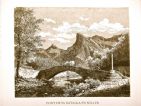 One of the panoramic views which best represent the wealth of Sóller’s valley is from the road to the port, barely half an hour’s walk and to which a good road leads along a stream running through the middle of the valley. To this end, we leave the town via the Carrer de la Mar and past orange tree groves delimited by low walls until reaching the stream populated by vigorous reeds, especially on the right bank. We follow the stream for a while before crossing the arched bridge, Pont de la Mar or Pont de La Batalla, where the new road to Deià will end. The bridge’s second name reminds us of the battle fought and won here by Captain Angelats, a victory remembered and celebrated in the town every year.
One of the panoramic views which best represent the wealth of Sóller’s valley is from the road to the port, barely half an hour’s walk and to which a good road leads along a stream running through the middle of the valley. To this end, we leave the town via the Carrer de la Mar and past orange tree groves delimited by low walls until reaching the stream populated by vigorous reeds, especially on the right bank. We follow the stream for a while before crossing the arched bridge, Pont de la Mar or Pont de La Batalla, where the new road to Deià will end. The bridge’s second name reminds us of the battle fought and won here by Captain Angelats, a victory remembered and celebrated in the town every year.
Just where the rocky hill of the “mola” meets the road with the rocky path to the port, is Port de Sóller castle which dates from the 16th century. The desolation following the Berber incursion led by the corsair, Dragut, in 1542, with the looting, the destruction of Santa Catalina Church and the bloody battle through which the town freed itself, led the then Governor of Mallorca, Felipe Cervellón, to think about how to avoid a second attack. Thus, at the expense of the inhabitants, construction on the castle began on January 6th, 1543, under the direction of Mestre Torres. Work had progressed so much in May 1545, that the canons were installed and effective in August of that same year. Five years later and bearing in mind that occurring in Genova at the hands of the same Dragut, the cisterns and more defensive structures were built, successfully preventing Occhiali’s army of Moors from docking at Sóller’s port on May 11th, 1561.
The castle crowns a rocky knoll populated by prickly pears and some carob trees. Its rear side is built like a rounded and slightly levelled tower measuring 9 “varas” in diameter and three rows of arrow-slits. It also includes an external staircase and a small wooden bridge. Over the door is Sóller’s coat of arms, and above that, Aragón’s. Above the latter, a perimeter cornice bears the inscription: “Any 1545, Saca Balo prese Frastio”. There is a domed chamber which served to house the soldiers. A spiral staircase rose to the Governor’s quarters under which was the dungeon.
Another spiral staircase leads from the soldiers’ quarters to the top of the tower paved in concrete and with a 7-foot-thick parapet, with various bastions, some wider to hold canons and others narrower for other weapons. There are three on the back end and 7 in the upper wall. The spiral staircase has an arrow-slit above to defend its entrance. The image from here of the port entrance and the two opposing lighthouses, one on Cap Gros cape and the other on Sa Creu point, is extraordinarily beautiful.
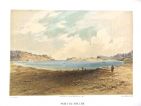 We continue on the road towards the port’s “moló” (breakwater) and take a few steps behind the stream with some fairly large maritime pines growing next to the beach and whose shade, next to a large “porxada” (archway), boats are built. We soon come to the houses in the port neighborhood, the majority aligned between the road and the rocky slope. The first is a bit lower than the rest. A beautiful pine tree shades the first house which has a wide front porch. The houses, perhaps 30 in number, are well constructed and comfortable and are not at all like the houses preceding them, today contributing to fishermen’s and seafaring folks’ wellbeing. Almost at the end of the street, near a festive tavern where travelers like to meet, is the San Ramón des Port or San Raimundo de Penyafort Church to which some rough steps lead up to from the road.
We continue on the road towards the port’s “moló” (breakwater) and take a few steps behind the stream with some fairly large maritime pines growing next to the beach and whose shade, next to a large “porxada” (archway), boats are built. We soon come to the houses in the port neighborhood, the majority aligned between the road and the rocky slope. The first is a bit lower than the rest. A beautiful pine tree shades the first house which has a wide front porch. The houses, perhaps 30 in number, are well constructed and comfortable and are not at all like the houses preceding them, today contributing to fishermen’s and seafaring folks’ wellbeing. Almost at the end of the street, near a festive tavern where travelers like to meet, is the San Ramón des Port or San Raimundo de Penyafort Church to which some rough steps lead up to from the road.
Almost in front of the church is where the breakwater begins, sheltering numerous coastal boats near the healthcare station. The road reaches there and goes even farther, till Sa Creu Point where the lighthouse by the same name stands. Opposite the “moló” to the west of where the Torrent de la Mar empties and at the base of the rocky Cap Gros cape crowned by its lighthouse is the now abandoned leper hospital.
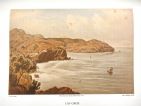 If, from Santa Catalina, we climb up the rocky slopes sprinkled with pine trees here and there, we soon come to the Paso de la Coma del Cingle and the panoramic view consisting of a large wall broken at three points, with cliffs falling into the sea, the crags of Santa Catalina and the prominent Cap Gros with its lighthouse. The wall is used in winter to gather goats if it’s cold out. On this peak populated by prickly pears we also find the Torre Picada tower which dates from the 17th century. With the aim of stopping ships from landing at Cala de Les Puntes cove, just as the Algerian pirates did in 1561 after having been expelled from Sóller’s port thanks to the cannon blasts from the castle, the Jurados decided to build this tower here, arguing that it could be defended effectively with few soldiers.
If, from Santa Catalina, we climb up the rocky slopes sprinkled with pine trees here and there, we soon come to the Paso de la Coma del Cingle and the panoramic view consisting of a large wall broken at three points, with cliffs falling into the sea, the crags of Santa Catalina and the prominent Cap Gros with its lighthouse. The wall is used in winter to gather goats if it’s cold out. On this peak populated by prickly pears we also find the Torre Picada tower which dates from the 17th century. With the aim of stopping ships from landing at Cala de Les Puntes cove, just as the Algerian pirates did in 1561 after having been expelled from Sóller’s port thanks to the cannon blasts from the castle, the Jurados decided to build this tower here, arguing that it could be defended effectively with few soldiers.
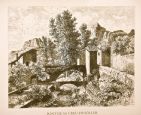 The path to Fornalutx starts from Carrer de l’Alqueria del Comte road and runs between orange trees then past a small watermill, some walnut trees and a grove of young orange trees. After following along the course of the Torrent de Fornalutx, it crosses several times with various bridges: first is Pont de Binibassí, followed a ways farther by another one next to a new garden for bitter oranges and a third bridge surrounded by terraces of orange trees.
The path to Fornalutx starts from Carrer de l’Alqueria del Comte road and runs between orange trees then past a small watermill, some walnut trees and a grove of young orange trees. After following along the course of the Torrent de Fornalutx, it crosses several times with various bridges: first is Pont de Binibassí, followed a ways farther by another one next to a new garden for bitter oranges and a third bridge surrounded by terraces of orange trees.
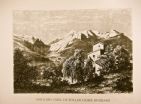 The path aligns itself once more with the rocky stream, its opposite shore protected by orange trees. Just there, on the left slope of the hill crowned by olive trees is the Possessió de Binibassí estate, with its grove of bitter orange trees which, before the disease affected them, were thought to provide the best of these fruits on the island. Binibassí, a name with Arabic resonance, is the ancient Apieibassa. It occupies one of the most beautiful spots in Sóller. A path paved by stones in the old fashion still climbs to the house: extensive, with a half-point arch doorway, the coat of arms, the topped square tower overlooking it, a facade with three windows and an irregularly-shaped inner patio. Up high is a bell tower with its corresponding bell. The rooms are comfortable, the main hall is spacious, and the rooftop is covered supported on four octagonal pilasters and a column, offering a splendid panoramic view of Sóller’s valley from Biniaraix to Son Angelats. No less charming is the view over the Barranc path, Biniaraix and the outcroppings of the Serra range. The same can be said of the view over a part of Coll de Sóller. A majestic weeping willow accompanies a trailing vine with views of Barranc.
The path aligns itself once more with the rocky stream, its opposite shore protected by orange trees. Just there, on the left slope of the hill crowned by olive trees is the Possessió de Binibassí estate, with its grove of bitter orange trees which, before the disease affected them, were thought to provide the best of these fruits on the island. Binibassí, a name with Arabic resonance, is the ancient Apieibassa. It occupies one of the most beautiful spots in Sóller. A path paved by stones in the old fashion still climbs to the house: extensive, with a half-point arch doorway, the coat of arms, the topped square tower overlooking it, a facade with three windows and an irregularly-shaped inner patio. Up high is a bell tower with its corresponding bell. The rooms are comfortable, the main hall is spacious, and the rooftop is covered supported on four octagonal pilasters and a column, offering a splendid panoramic view of Sóller’s valley from Biniaraix to Son Angelats. No less charming is the view over the Barranc path, Biniaraix and the outcroppings of the Serra range. The same can be said of the view over a part of Coll de Sóller. A majestic weeping willow accompanies a trailing vine with views of Barranc.
Fornalutx is a very small town which did not begin to have a life of its own until 1812 and it was not declared independent from Sóller until 1830. It has 903 inhabitants and 256 houses, 39 of which are uninhabited. Built into the slopes, almost all the houses consist of a single story, except six which have two. For the most part they are dark, with a half-point arch entrance. Almost without exception, none of them have been whitewashed. The doors open onto stepped little streets which run up and down the slope. The main one is called Carrer Major which stands out against the grey of the tall mountain. It leads to the Plaça Major with a well for the entire town at its center. The church here was almost certainly built between 1330 and 1365 by the people of the town themselves and dedicated to the Birth of the Virgin Mary or, as referred to generally here on Mallorca, La Mare de Déu de Setembre (Our Lady of September). The exterior is modest to an extreme. The main portal has a flat lintel. To the right, onto Plaça Major, another Gothic portal opens. Behind it, the square tower with pitched roof rises up. The church’s interior is also simple, with a vaulted ceiling supported on four arches, a heavy octagonal dome, the main altar chapel with vaulted ceiling and three chapels shaped like half-point arches on each side. The second of the left also has a dome. The choir is found above the entrance.
Next to the church is the old house belonging to Joan de Montcaire, with a square tower, arrow-slits and half-point arch portal which leads to an inner patio.
At the same height as Fornalutx but on the other side of the valley is Biniaraix along the picturesque mouth of the “barranc” (ravine). The place, though small, can be seen from a great distance as it occupies the top of a hill and stands out for the luminous white tower of its church. A branch off the path to Fornalutx takes you there, running past a grove of orange trees near a small creek and, behind some terraces full of olive trees, you come to the town on the right-hand side.
Biniaraix, with 467 inhabitants and 124 houses, is surrounded by orange tree groves which extend a long way down. It is 2.7 kilometers from Sóller. The houses are small and dark and have half-point arch doorways.
Its small church measures 22 meters long by 8 wide. It has a vaulted ceiling atop arches which start from flat pilasters. The main altar chapel is deep, and the altar is modern. It’s presided over by the image of the Conception of Mary, to whom the church is dedicated. There are chapels on either side. On one of the altars is a beautiful representation of Santa Catalina.
Amongst all the excursions worth taking from Sóller, none is as certainly gratifying as the one before us. That notwithstanding, it can be done on horseback right up to the very summit."
Archduke Ludwig Salvator of Austria. Las Baleares por la palabra y el grabado. Majorca: The island. Ed. Sa Nostra, Caja de Baleares. Palma de Mallorca. 1982.























